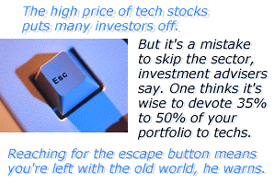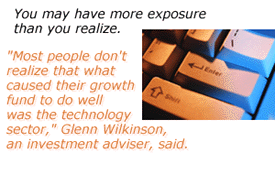|
Taking tech stocks to heart
|
 |
February 3, 2000: 6:26 a.m. ET
Investors shouldn't stand on the sidelines watching the world rush by
By Staff Writer Alex Frew McMillan
|
NEW YORK (CNNfn) - The Nasdaq keeps going sky high, but the Dow dips. A handful of stocks on the S&P 500 produce almost all its returns. There's a simple explanation: the technology boom is driving the markets, and that boom is expected to stick around for a while.
At the same time, Alan Greenspan, Warren Buffett and your next-door neighbor all tell you the prices of tech stocks are crazy. No earnings? No problem, some say. But many investors get a little nervous about whether to invest in technology, and if they're getting in at the right time.
The fear that the bubble will burst encourages conservative investors to skip tech stocks altogether. So how much technology should you own? And if you've already got some tech exposure, how much is too much?
Don't get stuck with the old world
"Should you own technology? The answer is, absolutely," said Larry Waschka, author of The Complete Idiot's Guide to Getting Rich. Not owning it means you risk owning only the old world, he explained.

And the old world hasn't been doing too well. Over the last three years, "if you take technology out of most portfolios, you're looking at flat or negative performance," he said. No wonder investment advisers say they often see people with a portfolio that's performing below the market average, or even losing money, wondering where they went wrong.
Waschka, who teaches investing seminars, comes across younger investors who use technology but think they'll only invest when they retire. But what he calls the "Bob Hope" generation of Americans over 50 seems to have the most trouble understanding tech stocks.
Older investors dismiss tech stocks as a fad or a bubble or just plain stupidly priced. "They are scared to death of this because they don't understand it," he said.
In Waschka's view, investors are paying prices now that should be paid five years down the road, "knowing that in 20 or 25 years these stocks are going to be the Cokes and Gillettes and Fords." That seems to help reluctant investors understand the high valuations of tech stocks, he said.
Brand to the future
Someone who invested $2,500 in Ford's company in 1903 would have had around $29 million by 1919, Waschka said. "And this (current tech boom) is the car industry on steroids," he added.
Investors have to take some stake, and some risk, he said. "They're going to be wrong in some cases. But you only have to be right a couple of times," he said.
With a quarter of the S&P 500 made up of tech stocks, investors probably want at least that amount of exposure. Waschka advises devoting 35 percent to 50 percent of a portfolio to technology of some sort.
Waschka invests in a focused portfolio of stocks based around companies he knows and uses. "I've got a Motorola phone on my hip right now. I've got a Dell computer behind me. I use AOL all the time. I've got a Palm Pilot in my hand and I know Cisco is involved in the infrastructure behind it all," he said.
So Waschka built a diversified portfolio around basic brand names and just six tech stocks: a computer maker, Dell (DELL); a chip maker, Intel (INTC); a software developer, Microsoft (MSFT); two communications-products makers, Qualcomm (QCOM) and 3Com (COMS); and an infrastructure creator, Cisco Systems (CSCO).
Funds help keep your heart from fluttering
But the Fed interest rate hike announced Wednesday could spell bad news for some techs. Investment gurus recommend diversifying your holdings, with the market acting unpredictably and Fed rate fluctuations likely in the near future.
Spread your stock picks among different tech sectors, as Waschka did, to spread your risk. Don't hold just Internet infrastructure companies or just computer makers or just dot.coms. If you want extra security, go for a technology fund.
The older you get, the more you might want to consider technology funds, said Glenn Wilkinson, an investment adviser with the Wilkinson Financial Group in Fayetteville, N.C., who specializes in counseling retirees. While younger people may be able to ride stocks through their ups and downs, Wilkinson says retirees need to protect what they have, so he sticks to funds.

"You're not going to hit a grand slam," he said. But he still saw his own IRA rise 62 percent last year investing in funds, thanks to technology and small-cap funds.
Investing in a technology-oriented fund means you can measure your technology exposure carefully. But it frees you from having to concentrate on individual stocks. Look for a no-load fund like the Invesco Technology funds, Waschka suggested.
You may have more tech than you realize
There's a third way to invest in technology, if even tech funds make you queasy: Invest in a diversified fund that has a large technology component. Waschka recommends the Value Line Special Situations fund.
With a diversified fund, you spread your risk across several different industries. But the right one will keep a good technology exposure to make sure the boom doesn't leave you behind.
Many investors do not realize they already have considerable tech exposure. "Most people don't realize that what caused their growth fund to do well was the technology sector," Wilkinson said. If you hold a growth fund, it will almost certainly have a technology component. Build that in to the calculations of the tech portion of your portfolio.
Any technology stocks and funds you have are likely to have outperformed lately. Investors who already have tech investments need to rebalance periodically to make sure they don't have too much tech exposure.
Make sure tech stocks are part of an overall asset-allocation plan that also gives you exposure to other areas, such as international stocks, value stocks and small-cap stocks. That way, even if you choose to overweight technology, you still have some backups in a downturn.
Dealer's choice
Whether you go straight for tech equities or stick with mutual funds "depends completely on the individual," said Stephen Barnes, portfolio manager with Barnes Investment Advisory in Phoenix. But he agrees that investors should have at least 25 percent-to-40 percent exposure to technology.
Diversification is particularly important with technology, Barnes continued. Investment advisers say you shouldn't have more than 10 percent of your net worth in any one stock. Some say you shouldn't have more than 5 percent in a company. The fewer stocks you have, the more important it is that they're in different sectors.
Spreading your wealth spreads your risk. And look for good values. "I don't believe all technology stocks can't be painted with a broad brush," Barnes said, and a good stock picker can still find decent values, he said.
Apple Computer (AAPL) presented a good buying opportunity for the last 18 months or so, for instance. And he liked Canadian telecommunications company BCE (BCE), which last week announced it is spinning off a chunk of Nortel Communications stock to its shareholders, because it didn't seem fully valued to Barnes. Since the announcement, though, it has risen to new highs.
Staying out of techs because of their high prices is a flawed strategy, Barnes said. "To say they look too expensive now -- I'm going to wait until the prices are better -- that to me is market timing," he said. Trying to time the market is something most investment gurus tell individuals to stay away from.
"You would have stayed out of them the last five years," which would have been a terrible mistake, Barnes said.
So buy in carefully, but buy in now, and use dollar-cost averaging to spread your risk by buying in over time. Yes, it's a risk. "But it's difficult to justify not owning technology," Barnes said. 
|
|
|
|
|
|
Track your stocks
|
Note: Pages will open in a new browser window
External sites are not endorsed by CNNmoney
|
|
|
|
 |

|

